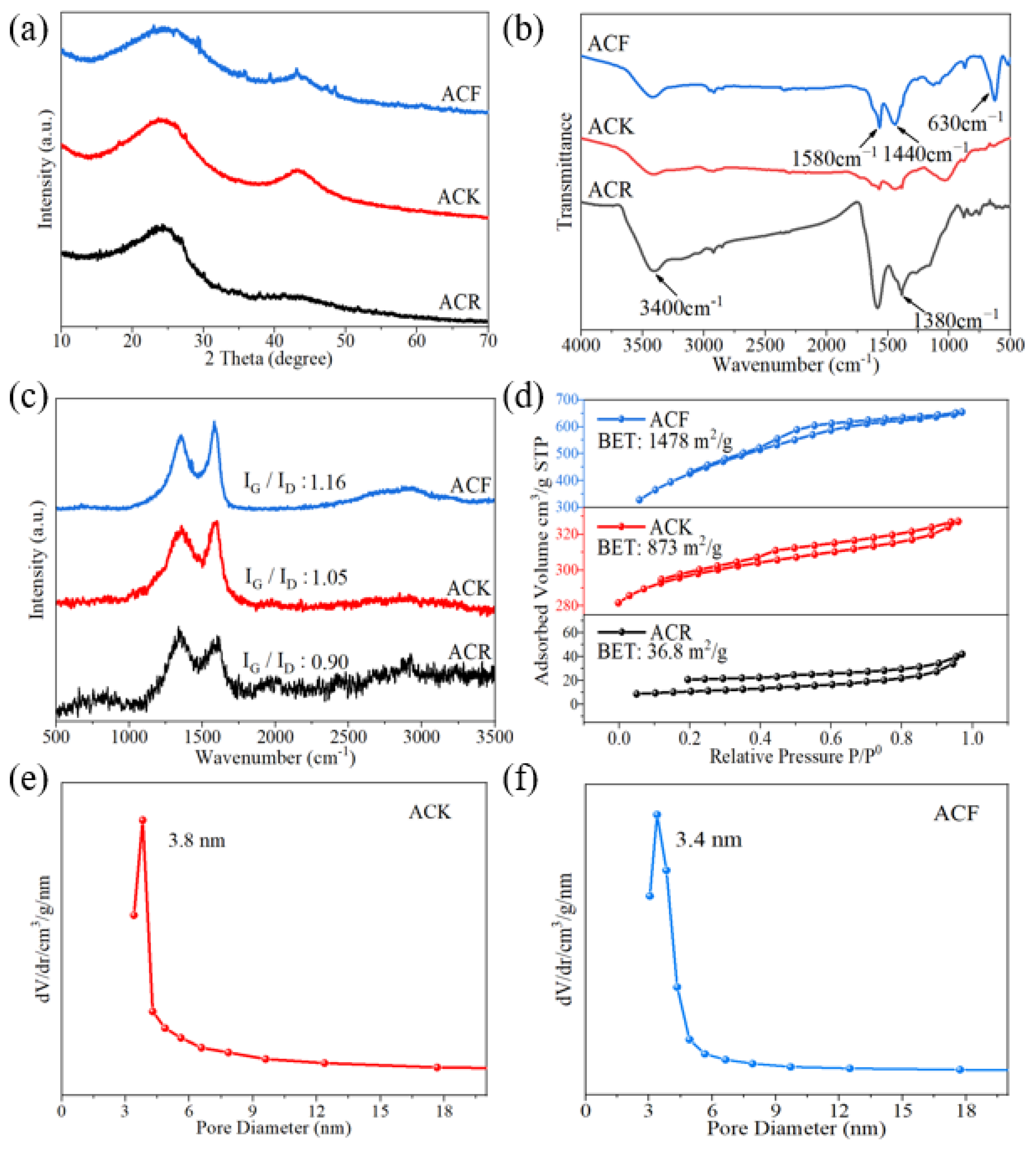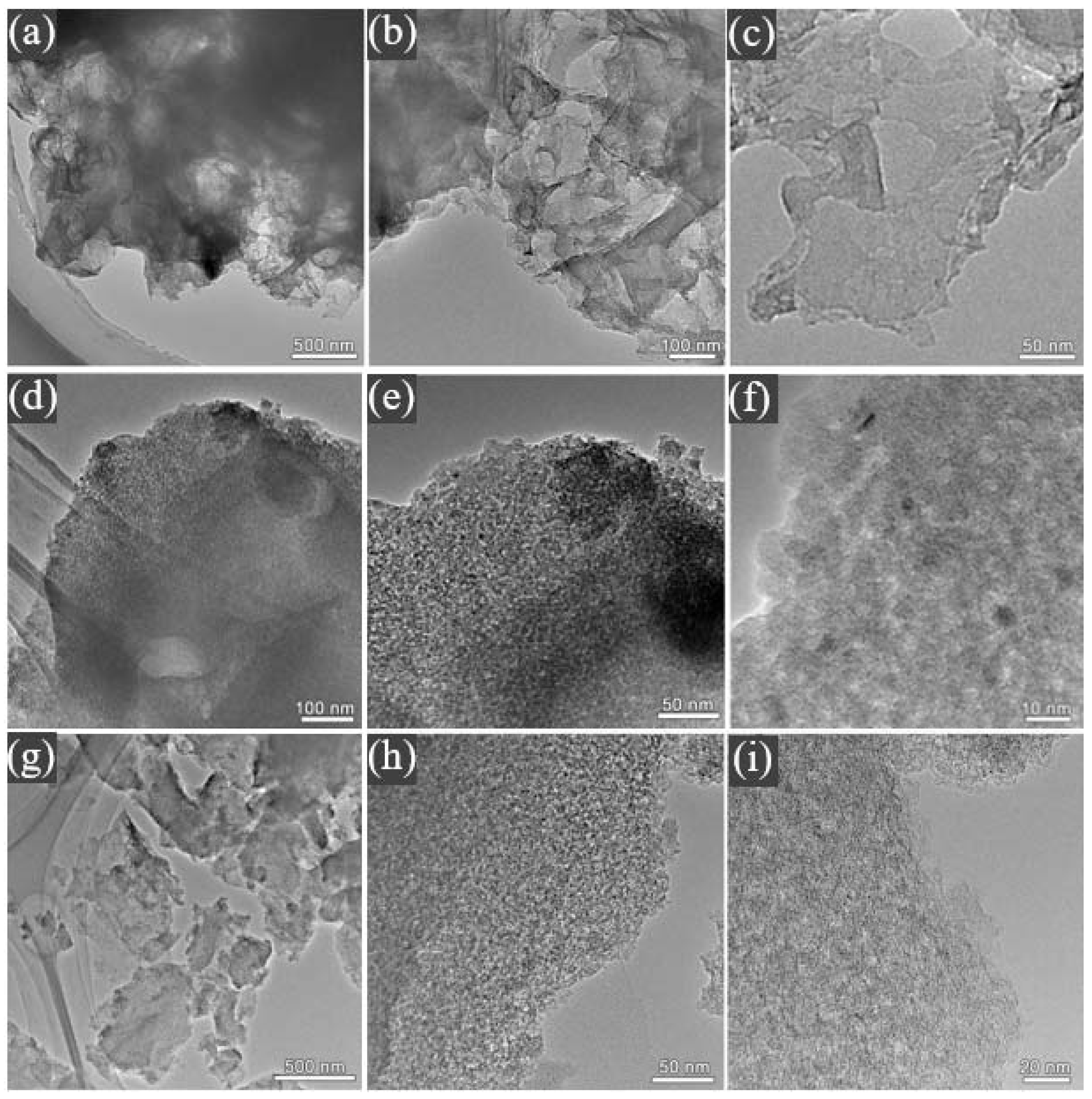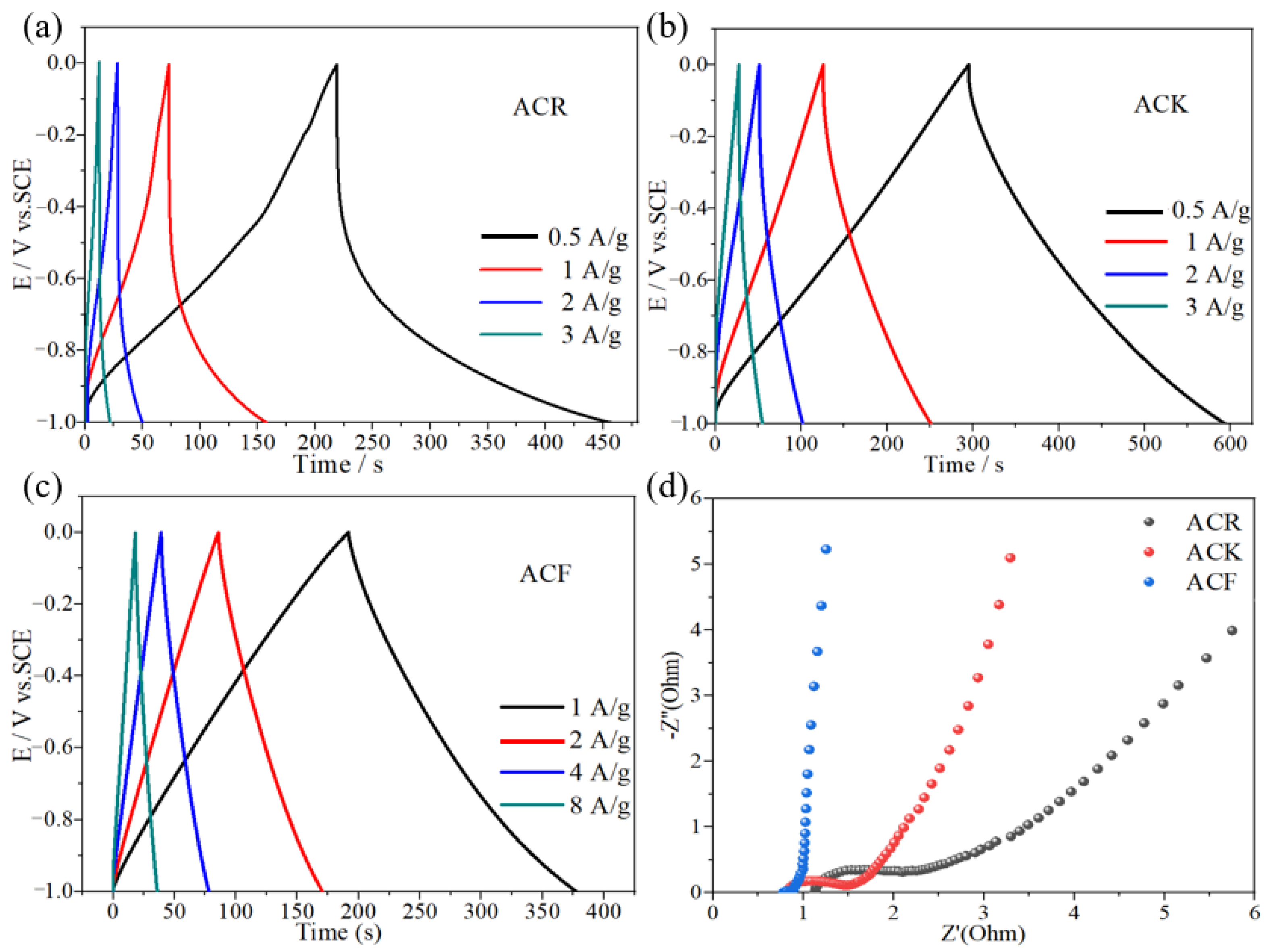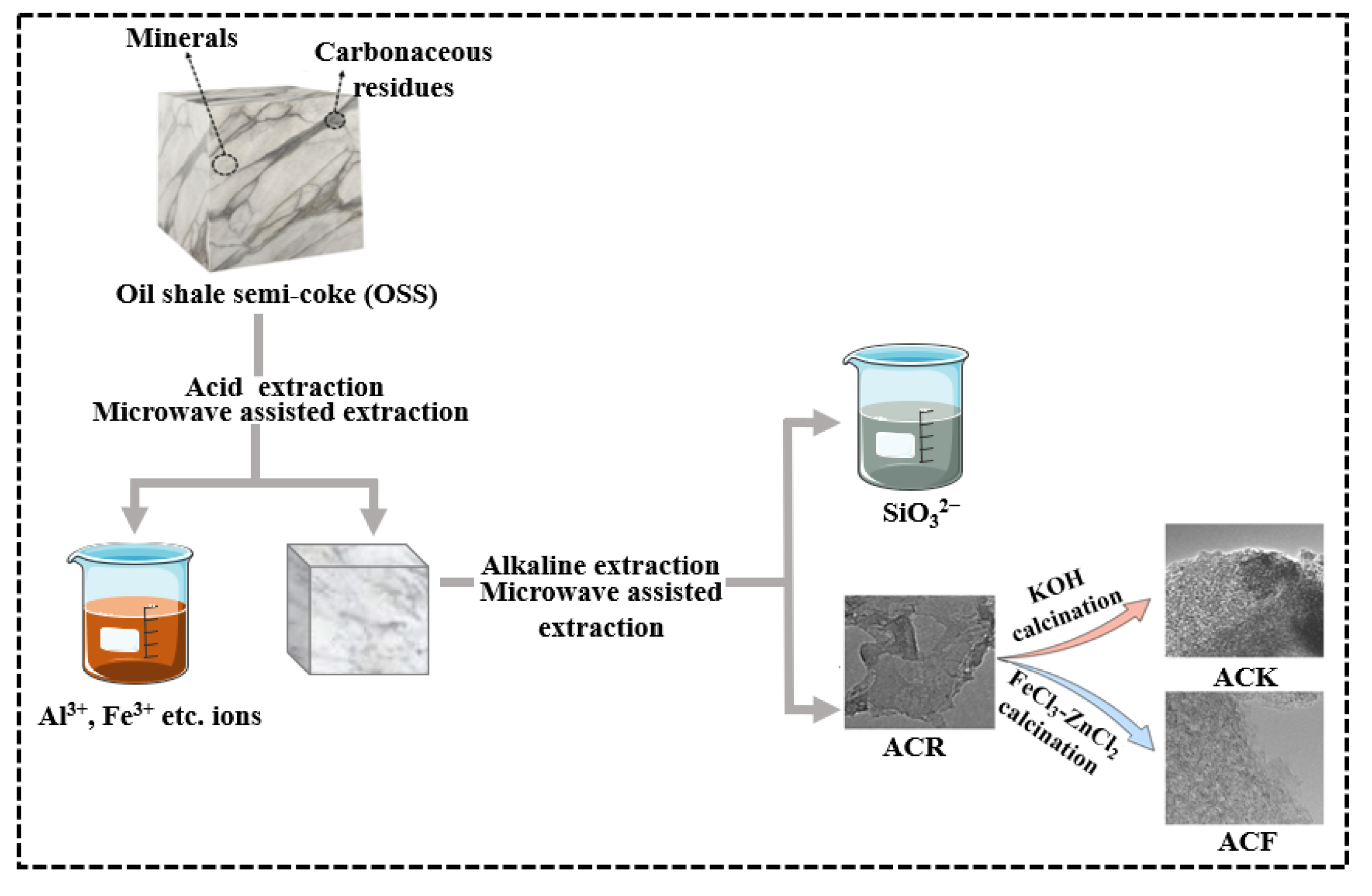Activated Carbon Derived from Waste Oil Shale Semi-Coke for Supercapacitor Application
Abstract
:1. Introduction
2. Results and Discussion
2.1. XRD Analyses
2.2. FT-IR and Raman Analyses
2.3. BET Surface Area Analyses
2.4. Morphological Analysis
2.5. Electrochemical Performance
2.6. Comparison with Other Activated Carbon
3. Materials and Methods
3.1. Materials
3.2. Preparation of Activated Carbons (ACR, ACK, and ACF)
3.3. Electrochemical Measurement
3.4. Characterization Methods
4. Conclusions
Author Contributions
Funding
Data Availability Statement
Conflicts of Interest
Sample Availability
References
- Li, X.; Shi, X.; Lu, M.; Zhao, Y.; Guo, R.; Peng, H. Improved nitrogen conservation capacity during composting of dairy manure amended with oil shale semi-coke as the porous bulking agent. J. Hazard. Mater. 2020, 388, 121742. [Google Scholar] [CrossRef]
- Li, B.; Wang, J.; Cao, G.; Nan, X.; Li, X.; Li, W.; Zhang, Y. Laboratory investigation and BP neural network modeling on heat-activated oil shale semi-coke attributable to the mechanical properties of concrete. Case Stud. Constr. Mater. 2023, 18, e0209. [Google Scholar] [CrossRef]
- Qin, H.; Wang, W.; Liu, H.; Zhang, L.; Wang, Q.; Shi, C.; Yao, K. Thermal behavior research for co-combustion of furfural residue and oil shale semi-coke. Appl. Therm. Eng. 2017, 120, 19–25. [Google Scholar] [CrossRef]
- Leo, V.; Olga, G.; Raivo, V. Environmental risks and problems of the optimal management of an oil shale semi-coke and ash landfill in Kohtla-Jarve, Estonia. Sci. Total Environ. 2015, 524, 400–415. [Google Scholar]
- Somprasong, S.; Yutthasin, B.; Lai, D.; Xu, G. Pyrolysis of Huadian Oil Shale in an Infrared Heating Reactor. Energy Fuels 2017, 31, 6997–7003. [Google Scholar]
- Han, X.; Kulaots, I.; Jiang, X.; Suuberg, E.M. Review of oil shale semicoke and its combustion utilization. Fuel 2014, 126, 143–161. [Google Scholar] [CrossRef]
- Shawabkeh, R.; Al-Harahsheh, A.; Hami, M.; Khlaifat, A. Conversion of oil shale ash into zeolite for cadmium and lead removal from wastewater. Fuel 2004, 83, 981–985. [Google Scholar] [CrossRef]
- Shawabkeh, R. Equilibrium study and kinetics of Cu2+ removal from water by zeolite prepared from oil shale ash. Process Saf. Environ. Prot. 2009, 87, 261–266. [Google Scholar] [CrossRef]
- Wen, X.; Luo, J.; Xiang, K.; Zhou, W.; Zhang, C.; Chen, H. High-performance monoclinic WO3 nanospheres with the novel NH4+ diffusion behaviors for aqueous ammonium-ion batteries. Chem. Eng. J. 2023, 458, 141381. [Google Scholar] [CrossRef]
- Yu, J.; Liu, S.; Duan, G.; Fang, H.; Hou, H. Dense and thin coating of gel polymer electrolyte on sulfur cathode toward high performance Li-sulfur battery. Compos. Commun. 2020, 19, 239–245. [Google Scholar] [CrossRef]
- Han, X.; Xiao, G.; Wang, Y.; Chen, X.; Duan, G.; Wu, Y.; Gong, X.; Wang, H. Design and fabrication of conductive polymer hydrogels and their applications in flexible supercapacitors. J. Mater. Chem. A 2020, 8, 23059–23095. [Google Scholar] [CrossRef]
- Qin, Y.; Liao, Y.; Liu, J.; Tian, C.; Xu, H.; Wu, Y. Research progress of wood-derived energy storage materials. J. For. Eng. 2021, 6, 1–13. [Google Scholar]
- Bhat, S.A.; Kumar, V.; Kumar, S.; Atabani, A.; Badruddin, I.A.; Chae, K.-J. Supercapacitors production from waste: A new window for sustainable energy and waste management. Fuel 2023, 337, 127125. [Google Scholar] [CrossRef]
- Wellars, U.; Yang, L.; Khurram, T.M.; Zhou, L.; Chen, R.; Lian, Y.; Yang, W. Electrode materials derived from plastic wastes and other industrial wastes for supercapacitors. Chin. Chem. Lett. 2020, 31, 1474–1489. [Google Scholar]
- Zhang, X.; Han, R.; Liu, Y.; Li, H.; Shi, W.; Yan, X.; Zhao, X.; Li, Y.; Liu, B. Porous and graphitic structure optimization of biomass-based carbon materials from 0D to 3D for supercapacitors: A review. Chem. Eng. J. 2023, 460, 141607. [Google Scholar] [CrossRef]
- Mehdi, R.; Naqvi, S.R.; Khoja, A.H.; Hussain, R. Biomass derived activated carbon by chemical surface modification as a source of clean energy for supercapacitor application. Fuel 2023, 348, 128529. [Google Scholar] [CrossRef]
- Khuong, D.A.; Trinh, K.T.; Nakaoka, Y.; Tsubota, T.; Tashima, D.; Nguyen, H.N.; Tanaka, D. The investigation of activated carbon by K2CO3 activation: Micropores- and macropores-dominated structure. Chemosphere 2022, 299, 134365. [Google Scholar] [CrossRef]
- Zhao, Z.; Sun, L.; Li, Y.; Feng, W. Polymer-derived carbon materials for energy storage devices: A mini review. Carbon 2023, 210, 118066. [Google Scholar] [CrossRef]
- Devi, R.; Kumar, V.; Kumar, S.; Sisodiy, A.K.; Mishra, A.K.; Jatrana, A.; Kumar, A.; Singh, P. Development of activated carbon by bio waste material for application in supercapacitor electrodes. Mater. Lett. 2023, 335, 133830. [Google Scholar] [CrossRef]
- Manasa, P.; Sambasivam, S.; Ran, F. Recent progress on biomass waste derived activated carbon electrode materials for supercapacitors applications—A review. J. Energy Storage 2022, 54, 105290. [Google Scholar] [CrossRef]
- Lozano-Castello, D.; Calo, J.M.; Cazorla-Amoros, D.; Linares-Solano, A. Carbon activation with KOH as explored by temperature programmed techniques, and the effects of hydrogen. Carbon 2007, 45, 2529–2536. [Google Scholar] [CrossRef]
- Morteza, O.; Omid, M. Microwave versus conventional sintering: A review of fundamentals, advantages and applications. J. Alloys Compd. 2010, 494, 175–189. [Google Scholar]
- Lazzarini, A.; Piovano, A.; Pellegrini, R.; Leofanti, G.; Agostini, G.; Rudić, S.; Chierotti, M.R.; Gobetto, R.; Battiato, A.; Spoto, G.; et al. A comprehensive approach to investigate the structural and surface properties of activated carbons and related Pd-based catalysts. Catal. Sci. Technol. 2016, 6, 4910–4922. [Google Scholar] [CrossRef] [Green Version]
- Yang, S.; Han, Z.; Zheng, F.; Sun, J.; Qiao, Z.; Yang, X.; Li, L.; Li, C.; Song, X.; Cao, B. ZnFe2O4 nanoparticles-cotton derived hierarchical porous active carbon fibers for high rate-capability supercapacitor electrodes. Carbon 2018, 134, 15–21. [Google Scholar] [CrossRef]
- Nian, Y.R.; Teng, H.S. Nitric Acid Modification of activated carbon electrodes for improvement of electrochemical capacitance. J. Electrochem. Soc. 2002, 149, A1008. [Google Scholar] [CrossRef] [Green Version]
- Qu, D.; Shi, H. Studies of activated carbons used in double-layer capacitors. J. Power Sources 1998, 74, 99–107. [Google Scholar] [CrossRef]
- Conway, B.E.; Pell, W.G. Double-layer and pseudocapacitance types of electrochemical capacitors and their applications to the development of hybrid devices. J. Solid State Electrochem. 2003, 7, 637–644. [Google Scholar] [CrossRef]
- Zhou, G.; Jiang, Y.; Deng, Z.; Qiu, F. Relationship between structure and specific capacitance of activated carbon with ultra-high specific surface area. Electron. Compon. Mater. 2006, 25, 34–37. [Google Scholar]
- Zhou, C.; Wang, X.; Duan, Z.; Hu, T.; Wang, H.; Gong, S.; Shi, S.; Chu, X. Construction of Sb-capped Dawson-type POM derivatives for high-performance asymmetric supercapacitors. Electrochim. Acta 2023, 442, 141823. [Google Scholar] [CrossRef]
- Rifat, F.; Ravindra, R.; Ramachandra, B.B.; Veena, S. Performance of an activated carbon supercapacitor electrode synthesised from waste Compact Discs (CDs). J. Ind. Eng. Chem. 2018, 65, 387–396. [Google Scholar]
- He, X.; Ling, P.; Yu, M.; Wang, X.; Zhang, X.; Zheng, M. Ice husk-derived porous carbons with high capacitance by ZnCl2 activation for supercapacitors. Electrochim. Acta 2013, 105, 635–641. [Google Scholar] [CrossRef]
- Ma, Y. Comparison of activated carbons prepared from wheat straw via ZnCl2 and KOH activation. Waste Biomass Valorization 2017, 8, 549–559. [Google Scholar] [CrossRef]
- Gou, G.; Huang, F.; Jiang, M.; Li, J.; Zhou, Z. Hierarchical porous carbon electrode materials for supercapacitor developed from wheat straw cellulosic foam. Renew. Energy 2020, 149, 208–216. [Google Scholar] [CrossRef]
- Cheng, M.; Kang, X.; Dou, J.; Gao, B.; Han, Y.; Xu, G.; Liu, Z.; Zhang, L. Preparation of activated carbon from cotton stalk and its application in supercapacitor. J. Solid State Electrochem. 2013, 17, 1005–1012. [Google Scholar] [CrossRef]
- Farma, R.; Deraman, M.; Awitdrus, A.; Talib, I.A.; Taer, E.; Basri, N.H.; Manjunatha, J.G.; Ishak, M.M.; Dollah, B.N.M.; Hashmi, S.A. Preparation of highly porous binderless activated carbon electrodes from fibres of oil palm empty fruit bunches for application in supercapacitors. Bioresour. Technol. 2013, 132, 254–261. [Google Scholar] [CrossRef]
- Hao, P.; Zhao, Z.; Tian, J.; Li, H.; Sang, Y.; Yu, G.; Cai, H.; Liu, H.; Wong, C.P.; Ahmad, U. Hierarchical porous carbon aerogel derived from bagasse for high performance supercapacitor electrode. Nanoscale 2014, 6, 12120–12129. [Google Scholar] [CrossRef]
- Guo, D.; Xin, R.; Wang, Y.; Jiang, W.; Gao, Q.; Hu, G.; Fan, M. N-doped carbons with hierarchically micro- and mesoporous structure derived from sawdust for high performance supercapacitors. Microporous Mesoporous Mater. 2019, 279, 323–333. [Google Scholar] [CrossRef]
- Li, Y.; Wang, X.; Cao, M. Three-dimensional porous carbon frameworks derived from mangosteen peel waste as promising materials for CO2 capture and supercapacitors. J. CO2 Util. 2018, 27, 204–216. [Google Scholar] [CrossRef]
- Thangavel, R.; Kaliyappan, K.; Kang, K.; Sun, X.; Lee, Y. Going Beyond Lithium Hybrid Capacitors: Proposing a New High-Performing Sodium Hybrid Capacitor System for Next-Generation Hybrid Vehicles Made with Bio-Inspired Activated Carbon. Adv. Energy Mater. 2016, 6, 1502199. [Google Scholar] [CrossRef]
- Chen, Y.; Zhang, Q.; Chi, M.; Guo, C.; Wang, S.; Min, D. Preparation and performance of different carbonized wood electrodes. J. For. Eng. 2022, 7, 127–135. [Google Scholar]
- Duan, G.; Zhang, H.; Zhang, C.; Jiang, S.; Hou, H. High mass-loading α-Fe2O3 nanoparticles anchored on nitrogen-doped wood carbon for high-energy-density supercapacitor. Chin. Chem. Lett. 2023, 108283. [Google Scholar] [CrossRef]
- Yang, J.; Li, H.; He, S.; Du, H.; Liu, K.; Zhang, C.; Jiang, S. Facile Electrodeposition of NiCo2O4 Nanosheets on Porous Carbonized Wood for Wood-Derived Asymmetric Supercapacitors. Polymers 2022, 14, 2521. [Google Scholar] [CrossRef]
- Guo, W.; Guo, X.; Yang, L.; Wang, T.; Zhang, M.; Duan, G.; Liu, X.; Li, Y. Synthetic melanin facilitates MnO supercapacitors with high specific capacitance and wide operation potential window. Polymers 2021, 235, 124276. [Google Scholar] [CrossRef]
- Ramirez, N.; Sardella, F.; Deiana, C.; Schlosser, A.; Müller, D.; Kißling, P.A.; Klepzig, L.F.; Bigall, N.C. Capacitive behavior of activated carbons obtained from coffee husk. RSC Adv. 2020, 10, 38097–38106. [Google Scholar] [CrossRef]






| No | Waste | Surface Area (m2 g−1) | Specific Capacitance (F g−1) | References |
|---|---|---|---|---|
| 1 | Waste compact discs | 1214 | 51 | [30] |
| 2 | Rice husk | 1768 | 171 | [31] |
| 3 | Olive residue | 1390 | 51 | [32] |
| 4 | Wheat straw cellulosic foam | 772 | 226.2 | [33] |
| 5 | Cotton stalk | 1481 | 114 | [34] |
| 6 | Oil palm | 1704 | 150 | [35] |
| 7 | Bagasse | 1892.4 | 142.1 | [36] |
| 8 | Saw dust | 1674 | 96.7 | [37] |
| 9 | Mangosteen peel waste | 1270 | 91 | [38] |
| 10 | Cinnamon sticks | 1540 | 53 | [39] |
| 11 | CW-beech | 1018 | 121.8 | [40] |
| 12 | NCW@Fe2O3 | 642 | 603 | [41] |
| 13 | NiCo2O4 | — | 1730 | [42] |
| 14 | MnO@CNP-2 | 393.9 | 545 | [43] |
| 11 | ACF | 1478 | 185 | This work |
| Steps | Power/W | Heat-Up Time/min | Control Temperature/°C | Hold Time/min |
|---|---|---|---|---|
| 1 | 700 | 8 | 100 | 3 |
| 2 | 1400 | 15 | 150 | 5 |
| 3 | 1400 | 15 | 200 | 15 |
Disclaimer/Publisher’s Note: The statements, opinions and data contained in all publications are solely those of the individual author(s) and contributor(s) and not of MDPI and/or the editor(s). MDPI and/or the editor(s) disclaim responsibility for any injury to people or property resulting from any ideas, methods, instructions or products referred to in the content. |
© 2023 by the authors. Licensee MDPI, Basel, Switzerland. This article is an open access article distributed under the terms and conditions of the Creative Commons Attribution (CC BY) license (https://creativecommons.org/licenses/by/4.0/).
Share and Cite
Xiong, C.; Wang, N.; Feng, M. Activated Carbon Derived from Waste Oil Shale Semi-Coke for Supercapacitor Application. Molecules 2023, 28, 4804. https://doi.org/10.3390/molecules28124804
Xiong C, Wang N, Feng M. Activated Carbon Derived from Waste Oil Shale Semi-Coke for Supercapacitor Application. Molecules. 2023; 28(12):4804. https://doi.org/10.3390/molecules28124804
Chicago/Turabian StyleXiong, Chu’an, Nan Wang, and Mai Feng. 2023. "Activated Carbon Derived from Waste Oil Shale Semi-Coke for Supercapacitor Application" Molecules 28, no. 12: 4804. https://doi.org/10.3390/molecules28124804





